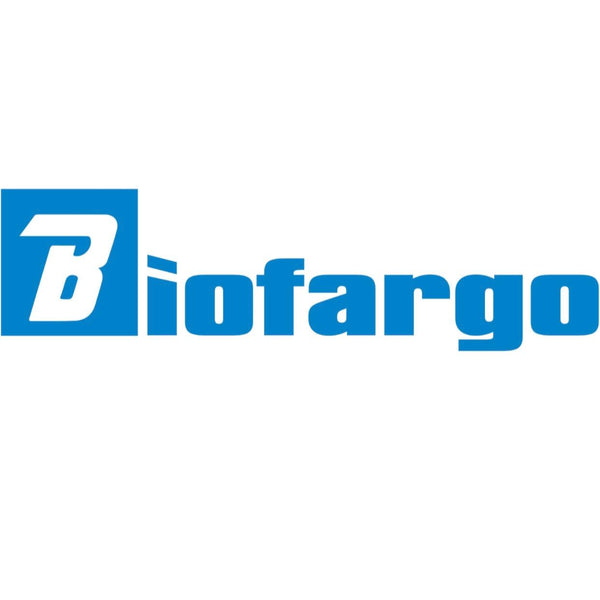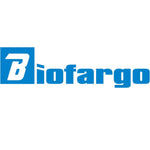You have no items in your shopping cart.
Description
Biofargo’s Sex-Determining Region on Y Chromosome Probe PCR Kit is designed for the quantitative detection of Sex-Determining Region on Y Chromosome (SRY) in a real-time PCR test using hydrolysis probes. In the same tube, Taq DNA polymerase amplifies the DNA via quantitative PCR using two primer-probe sets. One primer-probe set targets a SRY-specific DNA region and the other targets an endogenous Internal Control (IC) DNA region. At each cycle of the PCR, the 5’ nuclease activity of Taq DNA polymerase degrades the bound probes, releasing the quenched SRY-specific FAM signal and IC-specific Cy5 signal. The increase in FAM and Cy5 fluorescence measures the SRY-specific and IC-specific DNA amplifications, respectively. At a point where the fluorescence signal is confidently detected over the background signal, a Ct value can be determined. This Ct parameter can be used to evaluate relative target abundance among samples.
Features
1. One-tube PCR, minimized carry-over contamination.
2. High sensitivity, with an analytical LOD at 100 copies/reaction.
3. High specificity, no cross-reaction with DNA from other pathogens.
4. Amplification positive control is provided in the kit.
5. False positive result is ruled out by IC.
6. Compatible with various DNA purification methods.
7. Enough for 50 reactions, 20 μL per reaction.
8. Research use only.
Input Sample Requirements
-
Highly suggest to use DNA purified with Qiagen QIAamp Viral DNA Mini Kit or Thermo Fisher MagMAX Viral/Pathogen Nucleic Acid Isolation Kit
Kit Components
| Component Name | Product Number. | Size | Vial | Lid Color |
| 2×Probe qPCR MasterMix | 981201 | 0.5 mL | 0.5 mL Vial | Natural |
| Template Dilution Buffer | 180701 | 1 mL | 1.5 mL Vial | Green |
| SRY and IC Primer-Probe Mix Powder | yp17-001-sry | 50 T | 1.5 mL Vial | Brown |
| SRY Positive Control (1E7 copies/μL) | pc001-sry | 50 μL | 0.5 mL Vial | Yellow |
| Ultrapure Water | 210806 | 1 mL | 1.5 mL Vial | Blue |
| Manual | sc17-001-sry | 1 Set | NA | NA |
Storage and Handling
Reagents are shipped on ice and should be stored at -20℃ upon receipt. The kit remains stable for at least one year from the date of receipt. Repeated thawing and freezing of the kit components should be avoided. Before use, all components must be thawed at room temperature, placed on ice during handling, and returned to -20℃ after use. Thawed components should be mixed thoroughly by gently inverting or lightly vortexing prior to reaction setup.
Materials and Equipment Required but not Supplied in the Kit
| Class | Items |
| General laboratory equipment and consumables | Benchtop microcentrifuge, micropipettors, vortex mixer, disposable powder-free gloves, sterile pipette tips with filters |
| Kit-Specific laboratory equipment and consumables | Manual or automated DNA purification kits & equipment, real-time PCR instruments with FAM channel and Cy5 channel and consumables, PCR reaction preparation station, known positive sample and negative sample as controls |
Procedural Guidelines
-
Use purified DNA as starting materials.
-
Perform all steps at room temperature (20–25℃).
-
Use sterile, disposable Nuclease-free pipette tips and microtubes.
-
Wear disposable gloves while handling reagents and DNA samples.
Procedures
Section 1: Prepare 1E1-1E6 copies/μL Serial Dilutions for Standard Curve (SDSC)
Note: Since the concentration of the SRY Positive Control is very high, the following dilution operations must be carried out in an independent area, and the samples or other components of this kit must not be contaminated at all. The Positive Control is a DNA fragment from SRY.
1. Label six centrifuge microtubes as 6, 5, 4, 3, 2, and 1 respectively
2. Add 45 μL of the Template Dilution Buffer into each tube. Use filtered pipette tips (the same applies hereinafter).
3. Transfer 5 μL of the SRY Positive Control (provided in the kit, 1E7 copies/μL) into tube No. 6, and vortex vigorously for 1 minute. The concentration of the Positive Control in tube No. 6 is 1E6 copies/μL. Place the tube on ice for later use.
4. Change the pipette tip, transfer 5 μL of the diluent in tube No.6 into tube No. 5, and vortex vigorously for 1 minute. The concentration of the Positive Control in tube No. 5 is 1E5 copies/μL. Place the tube on ice for later use.
5. Change the pipette tip, transfer 5 μL of the diluent in tube No.5 into tube No. 4, and vortex vigorously for 1 minute. The concentration of the Positive Control in tube No. 4 is 1E4 copies/μL. Place the tube on ice for later use.
6. Repeat the above operation until six serial dilutions are obtained. Place them on ice for later use. They will be used as the templates for making the standard curve.
Section 2: Sample and reagent preparation
7. Perform N+2 DNA purification for N specimens per the guide from the manufacture of the DNA purification kit. One extra DNA purification is for DNA Purification Positive Control (PPC) using a known positive sample and the other for DNA Purification Negative Control (PNC) use a known negative sample or water. Store the purified DNA at -20℃ until use.
8. Thaw DNA samples and the kit reagents at room temperature before use. Once completely thawed, mix each component by gentle vortex or pipetting. Centrifuging DNA samples and the kit reagents briefly and then put them on ice.
9. When using the kit for the first time, add 220 μL Nuclease-free Water into the microtube that contains the SRY and IC Primer-Probe Mix Powder. Vortex the microtube for 10 seconds and spin it for 10 seconds. The solution is SRY and IC Primer-Probe Mix.
Section 3: PCR reaction set-up
10. Determination of total number of reactions per assay run. For N Test Samples, if only one replicate of PCR reaction is performed, the total number of reactions = N + 1 PPC + 1 PNC + 6 SDSC + 1 Amplification Negative Control (ANC) = N + 9.
11. Prepare Premix for one assay run of N + 9 reactions in a 1.5 mL tube according to the following table. Volume include 10% overage to make up transfer loss from pipetting.
| Component to Add | Volume for one reaction | Volume for one assay run |
| Probe PCR Buffer from the kit | 10 μL | 10 μL×(N+9)×1.1 |
| Probe PCR Buffer from the kit | 4 μL | 4 μL×(N+9)×1.1 |
| Total Volume | 14 μL | 14 μL×(N+9)×1.1 |
12. Set up N+9 reactions in PCR tubes according to the following table.
| Component to Add | ANC Tube | PNC Tube | PNC Tube | PPC Tube | 6 Standard Curve Tubes |
| Premix from step 5 | 14 μL | 14 μL | 14 μL each | 14 μL | 14 μL each |
| Template Dilution Buffer from the kit | 6 μL | - | - | - | - |
| PNC from step 1 | - | 6 μL | - | - | - |
| N Samples step 1 | - | - | 6 μL each | - | - |
| PPC from step 1 | - | - | - | 6 μL | - |
| 6 SDSC | - | - | - | - | 6 μL each |
| Total Volume | 20 μL | 20 μL | 20 μL each | 20 μL | 20 μL each |
Section 4: PCR
13. Perform PCR with the parameter described in the following table:
| Process | Process | Duration | Cycle Number |
| Denature | 95℃ | 1 cycle | 1 cycle |
| PCR | 95℃ | 15 seconds | 36 cycles |
| 52℃ | 15 seconds | ||
| 60℃ | 60 seconds, collect signal in FAM channel and Cy5 channel at this step |
Section 5: Data Analysis and Interpretation
14. Definition of Positivity: if there is no Ct value or the Ct value is greater than or equal to 36 in FAM channel or Cy5 channel, the sample is negative in the corresponding channel. If the Ct value is less than 36 in FAM channel or Cy5 channel, the sample is positive in the corresponding channel.
15. Validation of the purification experiment: If the PPC reactions is FAM positive and the PNC result is FAM negative, the DNA purification process is valid. Move on to step 17. If the PPC reactions is FAM negative or the PNC positive, the whole DNA purification process is invalid and there is no need to further analyze the test data. The DNA purification process must be repeated. The possible reasons for invalid purification include the disfunction of the DNA purification kits, mistakes in experimental processes, failures of PCR machine, or contamination of the PNC samples by carry-over from previous experiments or by other positive samples.
16. Validation of the amplification experiment: If at least 5 of the 6 reactions for SDSC are FAM positive and the ANC negative, the PCR amplification process is valid. Move on to next step. If less than 5 of the 6 SDSC reactions are FAM positive or the ANC positive, the whole PCR amplification experiment is invalid. There is no need to further analyze the data. The reason for invalid amplifications must be found. The possible reasons include the disfunction of the PCR reagents and the failure of PCR instruments, or contamination of the ANC samples by carry-over from previous experiments or by other positive samples.
17. If both purification and amplification results are valid, then analyze the results of the samples. For quantitative analysis, take the log value of the concentration of the six SDSC as the horizontal axis and the valid FAM Ct value as the vertical axis to draw a standard curve. Then, use the valid FAM Ct value of each samples to calculate the log value of the DNA concentrations from the standard curve, and then convert it to the DNA concentration in copies/μL. If the FAM signal is not detected or the FAM Ct is over 36, the reaction of this sample is negative only when the Cy5 signal is positive. If both the FAM signal and the Cy5 signal is negative, this reaction is invalid and must be repeated.
18. For qualitative analysis of the sample, if the FAM signal is S-shaped and the Ct is below 36, the reaction of this sample is positive, no matter the Cy5 signal of the same reaction is positive or negative. If the FAM signal is not detected or the FAM Ct is over 36, the reaction of this sample is negative only when the Cy5 signal is positive. If both the FAM signal and the Cy5 signal is negative, this reaction is invalid and must be repeated.
Limited Product Warranty
-
Biofargo, Inc. warrants its products as set forth in the Biofargo’s General Terms and Conditions of Sale at www.biofargo.com
-
If you have any questions, please contact us contact@biofargo.com
-
The information in this guide is subject to change without notice.
-
This product is intended for research purposes only. This product is not intended to be used for therapeutic and diagnostic purposes in humans or animals.
-
DISCLAIMER: TO THE EXTENT ALLOWED BY LAW, BIOFARGO INC. WILL NOT BE LIABLE FOR SPECIAL, INCIDENTAL, INDIRECT, PUNITIVE, MULTIPLE, OR CONSEQUENTIAL DAMAGES IN CONNECTION WITH OR ARISING FROM THIS DOCUMENT, INCLUDING YOUR USE OF IT.
Q: Can this kit be used for digital droplet PCR (ddPCR)?
A: Yes.
Documents
When can I expect my order to ship?
Most orders are filled and shipped within 2-3 business days from the time they are received.
Our standard shipping usually take 2-5 days.
We also provide express shippping for time-sensitive deliveries.
Email contact@biofargo.com if you have any requirements.



